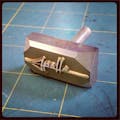The Soda Pop Robot project began a few years ago when I adapted a Paper Robot (similar to Kami-ROBO) design to fit onto an aluminum Can when unrolled.
If I could translate a paper toy design to recycled aluminum, lots of paper craft designs could then be made from colorful beverage cans. Scaling the robot parts to fit a 12 oz. can made the articulated robots 3" tall and would make good use of colorful aluminum cans instead of paper.
At the time two obstacles existed; transferring the design plans to the aluminum, and then cutting the aluminum parts accurately.
One method of transferring a 2d pattern into metal is a rolling die. A rolling die is 2 wheels that contain the design which press-cut materials fed between the wheels - this would be a fast method for manufacturing these low cost recycled toy kits.
Before investing in a rolling die- I had to prove my robot design to make them easy to assemble, and function as stop motion articulated figures. In order to make the first prototypes I printed the 2D plans on sticker paper. Then I would apply the stickers to the aluminum cans and then cut the perimeter shapes with scissors and drill the holes with a Dremel tool.
The problem was my hand cut samples were never accurate enough to prove the functional details of the design before investing in the roller die tooling. So the project sat in a box for awhile.
CNC MachineFast forward 5 years and we have the Nomad 883 Desktop CNC machine which can easily cut aluminum sheets.
The first the trick would be holding the .005" thick material during the machining process, and after experimenting with blue fixturing wax that works well on most metals, hot glue was found to work best.
The plans for the robot parts were modified to make folding easier, by placing a circle at each intersection to be folded. Where possible, an extra tab that can be folded and pinched was added, removing the need for any tape or adhesives during the assembly process.
One great thing about making things you've never made before is the wonderful discovery process, an example of this occurred while experimenting with different hinge-rod options for the joints. I tested piano wire, paper clips, brass rod, and even paper rope which were all to hard or too soft and failed to offer the articulated control necessary for stop motion.
Finally, while rummaging in the parts bins, I found some resistors, which where the perfect strength and enabled a solder joint to be placed at the 2 points of greatest leverage during figural posing; the hips and collarbone.
The final key to creating a fully posable stop motion capable action figure was a spring. By feeding a compression spring around the resistors, pressure was applied to the hip joint, internally allowing for controlled leg placement.
With a material cost of around 20 Cents - these soda POP robots might be the biggest bang for your buck DIY project you can build. Even more exciting than making metal robots may be the thought of all those paper-craft designs which can now be re-created in METAL, and with a rich canvas of colors offered with canned beverages.
I am excited to see what people make using recycled aluminum cans with modern desktop CNC machines and software like the Nomad 883 and Carbide Create.
You can download the Soda POP Robot Files here.
-Apollo










Comments
Please log in or sign up to comment.